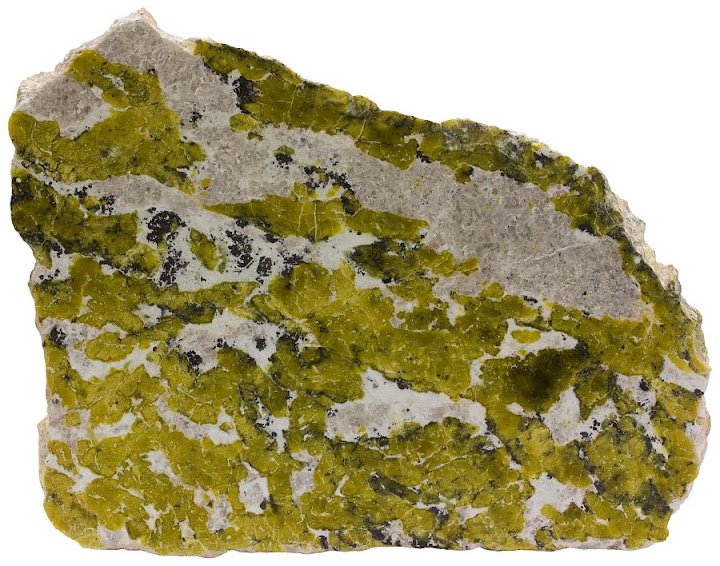Magnesite is a magnesium carbonate mineral (MgCO3). Unlike related carbonates calcite (CaCO3) and dolomite (CaMg(CO3)2), it is not a major rock-forming mineral. It most commonly occurs in metamorphosed igneous rocks which are rich in magnesium. These are ultramafic rocks like dunite, pyroxenite and peridotite. These rocks commonly metamorphose to serpentinite.

Magnesite (white) with serpentine from Norway. Width of sample 24 cm.
Low- or medium-grade metamorphism of ultramafic rocks may also yield magnesite if there is enough carbon dioxide available which is needed to form the carbonate ion. But it is not restricted to these often beautiful green-white assemblages. It also occurs in hydrothermal veins and in sedimentary rocks. Sometimes sedimentary dolomite is replaced with it (calcium in the lattice is replaced with magnesium) in which case the magnesite is said to be diagenetic. It may infrequently precipitate directly from salty brine.
Magnesite is usually white, although it may be yellow or brown if some of its magnesium is replaced with iron. There is a complete solid solution between siderite (FeCO3) and magnesite just as there are similar solid solutions possible in many other iron-magnesium minerals, for example olivine.
Magnesite, like dolomite, reacts with dilute hydrochloric acid only if powdered or if the acid is heated. Unlike calcite it very rarely forms well-developed crystals. This is why its crystals are highly valued by mineral collectors, although the mineral itself is not particularly rare. Beware of cheaters if you want to buy these crystals. They may be actually calcite (iceland spar) which is similar in appearance. Real magnesite crystals usually come from Brumado, Brazil.
The mineral is usually earthy or granular. It may be very fine-grained, sometimes said to be amorphous. This is incorrect because it is still composed of crystalline matter (‘amorphous’ means without crystal structure), these crystals are just too small to be seen. Magnesite is denser (specific gravity 3-3.2, depending on the composition) than many other common rock-forming minerals and it is also relatively soft (3.5-4.5 on Mohs scale).
It could be used as an ore of magnesium, but usually magnesium is extracted from brines and seawater. Every cubic meter of seawater contains more than one kilogram of magnesium. So there is really no shortage of this metal and never will be. River water usually contains very small amounts of magnesium (only about 4 ppm), but it gets concentrated in seawater because rivers constantly carry more and more of it but there are no easy ways out. It is actually a minor biomineral. Some cyanobacteria are involved in biologically induced magnesite formation, but this is relatively minor part of the magnesium cycle.
Magnesite is mined but rarely as an ore of magnesium. Instead, it is heated (625…643°C is required) to produce MgO (periclase as a naturally occurring mineral, but as a manufactured white powder it is known as magnesia or dead-burned magnesite) which is used mainly in the manufacture of refractory materials. More than half of produced magnesia is used by the refractory industry, but magnesia has many other industrial applications. It is even used as a plant fertilizer and as a desiccant in libraries.

Hydromagnesite sand grains from Lake Salda in Turkey. Green is serpentine. Width of view 15 mm.

Massive variety (sometimes said to be amorphous) from the Ural Mountains in Russia. Width of sample 12 cm.

Magnesite from Satka (Satkinskoye) in Russia. Satka is the largest sedimentary deposit (dolomite replaced by magnesite) of magnesite in the world. Width of sample 11 cm.
Leave a Reply